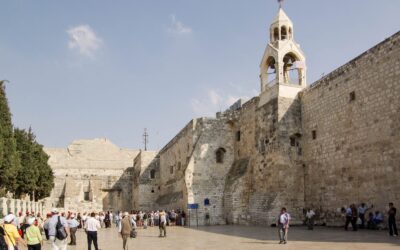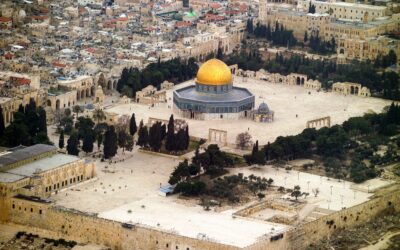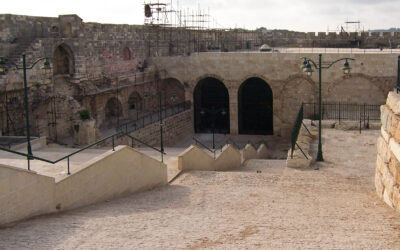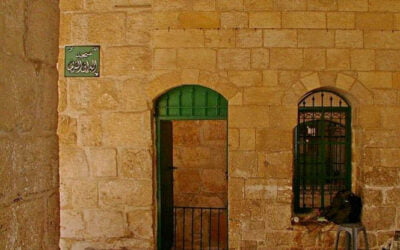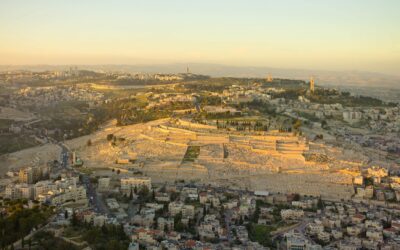THE CITY GATES OF JERUSALEM
-
The gates of Jerusalem were built in the early 16th century by the Ottoman Sultan Sulayman the Magnificent into the existing city walls. Today, there are eight gates in total and apart from just one, the remainder still serve this holy city. Four of the gates of Jerusalem face the cardinal directions; the Damascus Gate to the north, the Golden Gate to the east, the Nabi Dawud Gate to the south, and the al-Khalil Gate to the west. The remaining gates are the Herods Gate, the Lion Gate, the Maghrabi Gate, and the New Gate.
-
Damascus Gate
The Damascus Gate is built on northern side of the city. After entering through this gate, one enters into the Arab market which offers fresh fruit and vegetables. It is a bustling hub for Muslim population of the city. It is the most beautiful gate of the Jerusalem Wall and the richest in terms of architectural and decorative design. Like most of the other gates, its dates back to the time of Sulayman the Magnificent.
-
Golden Gate
This is an ancient historical door in the Eastern Wall of Musjid al Aqsa. The Gate’s two vaulted halls lead to Bab al-Rahmah(The Gate of Mercy) and Bab al-Tawbah(The Gate of Repentance). Bab ar Rahmah was named after the Rahmah Graveyard, which is located in front of it. This gate has been closed for more than 1000 years. At the base of the gate lies a Musjid which has been reopened for use. Christians believe that the Messiah (Jesus) will enter through this gate upon his return.
-
Nabi Dawud Gate
The gate takes its name from the tomb of Nabi Dawud AS which lies very close to it. Also known as the Zion gate, it leads to the Armenian and Jewish quarters of the Old city.The gate bears the unpleasant bullets marks of the 1948 War.
-
Al-Khalil Gate
The gate has been named after the city of Khalil (Hebron) as it faces in its direction. It is also known as the Jaffa Gate and acquired that name due to the Jewish and Christian pilgrims who used to disembark at the Jaffa port and then enter Jerusalem through this gate.
The gate is characterised by a foundation inscription that is relatively longer than similar inscriptions on other gates and towers. The inscription is similar to those on the fountains of Sultan Sulayman which suggests that the team that was responsible for constructing the fountains was involved in construction in the area of Bab al-Khalil as well. The inscription, in addition to having the sultan’s titles and date, reads: “Has ordered the construction of this blessed wall, our master, the greatest sultan and honourable Hakan, who rules the necks of the nations, sultan of the Rum, the Arabs and the non-Arabs. (The) sultan of the two Seas and two continents, Sultan Sulayman, son of Sultan Salim Khan, may Allah perpetuate his reign and his sultanate, in the month of Jumada al-Awwal of the year 945”(October 1538) Around 1887, the French ambassador in Turkey asked the Ottoman Sultan Abdul Hamid II if he would consider building a gate to simplify the travel for Christians. The Sultan kindly agreed, and another gate of the city came into being.
-
Al-Zahar Gate
It has been named the Flowers (Zahar) Gate due to the floral designs in its architecture. It is also known as the Herod’s Gate because it was believed to have led to a structure erroneously identified as King Herod’s Palace.
It is in this area of the city walls, that the Crusaders penetrated the walls to capture the city from the Muslims in 1099CE.
-
Lions Gate
Lions Gate in the old city walls of Jerusalem leads to the Muslim Quarter. It is also known as Stephen’s Gate. It takes its name from the four animals that were understood to be lions which are engraved on the exterior of the gate. In reality, these are tigers which were the heraldic symbol of the 13th-century Sultan Baybars. The gate was originally built with an L-shaped structure, similar to the other Ottoman gates of Jerusalem. However, this L-shaped structure was later altered in order to allow vehicle access.
- Maghrabi Gate
The Maghrabi (Moroccan) Gate was named after the large number of North Africans who settled close to this gate. It is also referred to as the Dung gate as refuse used to be dumped in this area at some point in its history. It is a very old gate and is said to have been in use since the days of Sulayman AS. This gate leads directly to the Western Wall which is used by Jews to enter the Haram al-Sharif. Musjid Buraq is situated next to the gate aand the wall is therefore known as the Buraq wall. It is the same wall which is called the Wailing Wall by Jews where they recite their prayers. The area just outside the gate was known for its madrassahs, libraries, Musjids and hostels that were put up by Salah al-Din during his rule. He had created a hub of education in this area and thousands of Muslims inhabited this area. During the British-era many Jews settled here and were welcomed by the locals. Sadly however, in 1967 when the city was forcefully taken, the Muslims were given just 3 hours to vacate their homes and the entire neighbourhood was demolished.
-
New Gate
The New Gate was built to allow easy access for Christians who wanted to reach the Christian Quarter from the many Christian monasteries outside the walls of the city. It is a ‘new’ gate as it wasn’t planned in the original design of the city walls. It is therefore more of an opening in the wall than an actual gate. Around 1887, the French ambassador in Turkey asked the Ottoman Sultan Abdul Hamid II if he would consider building a gate to simplify the travel for Christians. The Sultan kindly agreed, and another gate of the city came into being.

